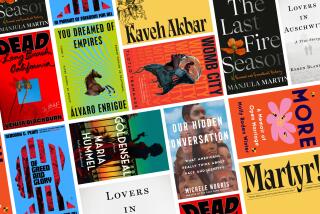âThe Thing Around Your Neckâ by Chimamanda Ngozi Adichie
The Thing Around
Your Neck
Stories
Chimamanda Ngozi Adichie
Alfred A. Knopf: 216 pp., $24.95
Imagine how hard it must be to write stories that make us thick-headed American readers understand what it might be like to visit your brother in a Nigerian jail, to be the new bride in an arranged marriage, to arrive in Flatbush from Lagos to meet your husband or to hide in a basement, waiting for a riot to subside, wondering what happened to your little sister who let go of your hand when you were running. How would it feel to be a woman who smuggled her journalist husband out of Nigeria one day and had her 4-year-old son shot by government thugs the next?
Hereâs how it makes this reader feel: afraid. Not grateful or sad or outraged but caught between two worlds and frightened. If reading stories can make you feel this way, what would it be like to live them? There might be a kind of hopelessness that no one could ever really understand; maybe shame that you were turning hardship into art. What would you hope to make your readers do? Protest? Feel the tugging of the ties that bind us as humans? Believe that each humiliation, each violence, creates a scar in our human DNA? Would you perhaps hope to punish us, readers in the Western world, for our security, to crack it open, to say, âThis could happen to youâ?
Chimamanda Ngozi Adichie uses the second person in many of the stories in âThe Thing Around Your Neckâ to strange effect. Rather than making them more personal, the âyouâ creates a formal distance between writer and readers, making them feel theyâre being asked, âWhat would you do?â The thing around the narratorâs neck in the title story, for example, becomes a thing that exists in the air between us, a thing we can look at together and try to make sense of.
This is Adichieâs third book, and it is fascinating to see her style preen itself to an elegant whisper. Her first novel, âPurple Hibiscus,â told the story of a teenage girl, growing up in Nigeria, who breaks out from under her authoritarian family. The second, âHalf of a Yellow Sun,â the story of a 13-year-old boy, was set in 1960s Nigeria as Biafra was fighting for its independence. In her collectionâs 12 new stories, characters (many in their teens and early 20s) feel a yanking on invisible collars as they try to strike out on their own. Sometimes, ties are cut by distance (Adichie divides her time between the United States and Nigeria), leaving a protagonist disoriented and alone: âIf a fortune-teller had told her that she, in the space of a few days, would no longer recognize her life, she would have laughed.â
Sometimes a lie or a death cuts the lines of trust that tie a character to the world they inhabit. Most of Adichieâs characters are alone, adrift in a strange physical or emotional landscape. âWhite people who liked Africa too much and those who liked Africa too little were the same -- condescending,â thinks a young woman who has been sent to live with an uncle in America, gets raped in her bedroom and leaves the next day.
These characters feel invisible, erased. They canât go home. They want to melt into America. What would it be like to feel that sinister thing, memory, around your neck? Perhaps you can imagine after all.
Salter Reynolds is a Times staff writer.
More to Read
The biggest entertainment stories
Get our big stories about Hollywood, film, television, music, arts, culture and more right in your inbox as soon as they publish.
You may occasionally receive promotional content from the Los Angeles Times.










